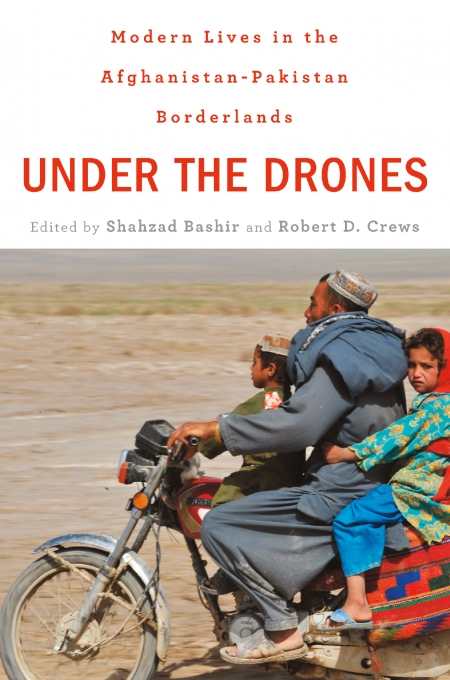It looks like you've stumbled upon a page meant to be read by our code instead of viewed directly. You're probably looking for this page.
Under the Drones
Lives in the Afghanistan-Pakistan Borderlands
During a visit to a commander who controlled provinces in northern Afghanistan, a Pakistani journalist spotted blood and chunks of flesh in the courtyard. He was told that the commander had just handed out punishment to a soldier. For his crime of stealing, the man “had been tied to the tracks of a Russian-made tank, which then drove around the courtyard crushing his body into mincemeat.” In neighboring Pakistan, which shares a long border with Afghanistan, three teenaged Baloch girls were shot, dumped in a ditch, and buried alive in 2008 because they wanted to choose their own husbands. A Baloch member of Pakistan’s parliament defended the act because it was part of “centuries-old traditions”; a few months later he was appointed minister of Postal Services. Appalling brutality is not a modern phenomenon in these lands: during a skirmish with the Afghans in the early sixteenth century, Babur’s soldiers killed dozens in battle, and when the remaining men surrendered, he built a pillar of their heads in his camp.
Violence, repression of women, and the opium trade have figured prominently in recent news stories about the Afghanistan-Pakistan borderlands. Of the events in 2011 that generated coverage by reporters, two stand out: the killing of Osama bin Laden by United States forces and a CBS television broadcast that questioned Greg Mortenson’s account of his adventures in Pakistan prior to his work with girls’ education in the region. By focusing attention on the two foreigners, the coverage continues a decades-old practice of elevating outsiders and their perspectives over those of the local population.
In Under the Drones, Shahzad Bashir and Robert Crews, faculty members at Stanford University, present contributions by journalists, economists, historians, and other social scientists that aim to “provide a corrective to mainstream media’s portrayal of the Afghanistan-Pakistan borderland.” Western analysts, the editors suggest, think of the region’s people as living fossils stuck in a “time warp of unchanging ‘tribal’ traditions.” The West engages with the region through remotely piloted drone aircraft, conducting surveillance and “unleashing lethal fire on suspected militants below,” imagining a “contest between the sophisticated technology of the modern, civilized West and the savagery of a backward foe.” The editors believe that “individuals and communities that inhabit the borderlands have been written out of the stories of their own lives.”
Some of the authors are of Afghan or Pakistani origin; many have researched and written about the two countries for years; and all highlight local voices and opinions in their contributions. A chapter on Pashtun and Punjabi truck decoration discusses the images of leaders, animals, and slogans that appear on the “moving murals” that transport goods in Pakistan. Truck owners spend the equivalent of thousands of dollars to get the vehicles painted, usually permitting their drivers to select pictures and designs; the images that result constitute “the largest art industry in the country” and offer a glimpse of religious, political, and cultural ideas that matter most to thousands of Pakistanis. Portraits on the trucks include those of singer Nusrat Fateh Ali Khan and Muhammad Iqbal, a poet; portraits of contemporary generals and rulers are not considered appropriate because “the leadership of modern Pakistan is not viewed by truckers as representing themselves either politically or ideologically.” Among the other topics discussed in the book are Sufism, ethnic identity, women’s roles in the Afghan drug trade, and religious schools.
About Pashtunwali, the unwritten code that governs social interactions among the Pashtuns of Afghanistan and Pakistan, Winston Churchill wrote: “Their system of ethics, which regards treachery and violence as virtues rather than vices, has produced a code of honour so strange and inconsistent that it is incomprehensible to a logical mind.” Under the Drones will not displace the notions that Western observers often associate with the Afghanistan-Pakistan region—mindless cruelty, female oppression, and a flourishing opium economy. But the book will help readers to make sense of the economic and social forces that motivate the actions of the borderlands’ inhabitants and to understand that the local population is not an empty slate to be written upon by agents from the outside.
Reviewed by
Karunesh Tuli
Disclosure: This article is not an endorsement, but a review. The publisher of this book provided free copies of the book to have their book reviewed by a professional reviewer. No fee was paid by the publisher for this review. Foreword Reviews only recommends books that we love. Foreword Magazine, Inc. is disclosing this in accordance with the Federal Trade Commission’s 16 CFR, Part 255.
